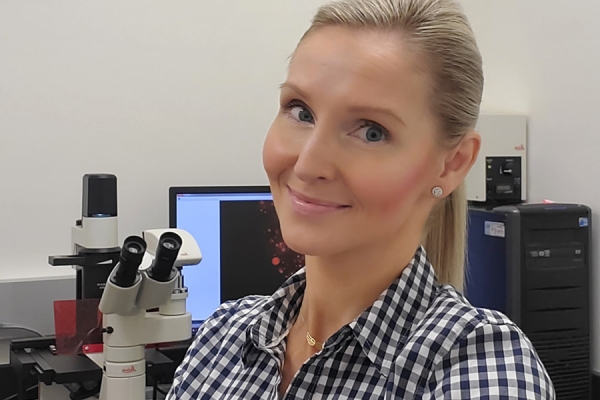 Research associate Dorota Lubanska is part of a team studying the use of nanoparticles to target and treat the aggressive brain cancer glioblastoma.
Research associate Dorota Lubanska is part of a team studying the use of nanoparticles to target and treat the aggressive brain cancer glioblastoma.
UWindsor researchers have come together to explore a novel potential treatment for an aggressive type of brain cancer.
The scientists are studying the use of nanoparticles to target and treat glioblastoma (GBM).
The collaborative UWindsor team published their findings in the article “Impairing proliferation of glioblastoma multiforme with CD44+ selective conjugated polymer nanoparticles” in the journal Scientific Reports.
Dorota Lubanska (PhD 2013), research associate in the biomedical sciences lab of Lisa Porter, led the biological side of the study.
“You can treat GBM with chemotherapy and radiation, but the tumour contains small populations of tumour-initiating cells, or cancer stem cells, which are highly resistant to these therapies,” says Dr. Lubanska.
“These cells stay behind, leading to the tumour recurrence, patient relapse, and eventually, death.”
Lubanska says she loved this project because of the collaboration and that together they looked for out-of-the-box solutions to target those tumour-initiating cells.
“I’ve learned through the years that effective and patient-applicable research requires collaboration; it can’t be done in just one lab,” she says.
“We can be so much more successful when we work together, exchange ideas, and share expertise to achieve the goal of finding something that will improve people’s lives.”
Gage Mason is a PhD student working in Simon Rondeau-Gagné’s chemistry lab. He says the collaborative efforts with Dr. Porter’s team created an opportunity to prepare novel nanoparticle systems that could be investigated and integrated in brain cancer models, while allowing their team to perform a plethora of experiments to test new organic materials for cancer treatments.
“As researchers, we both had visions of treating GBM through non-invasive methods, but neither of us had the complete toolset to make that vision happen by ourselves,” says Mason.
“Through this collaboration, we were able to work with Dr. Lubanska to tailor and optimize the chemistry behind these nanoparticles, ensuring the highest compatibility with the cellular systems being worked on.”
Glioblastoma has a survival rate of less than 15 months. The tumour-initiating cells evade therapies like radiation and chemotherapy in part because they express molecules on their surface, but these markers also give researchers the opportunity to study the cells more closely.
“In our study we targeted a receptor protein called CD44,” Lubanska says. “It is a marker for tumour-initiating cells and a driver of several aggressive aspects of glioblastoma like invasiveness, proliferation, resistance to cell death.”
This is where the nanoparticles came in. Designed by Dr. Rondeau-Gagné, they are coated with hyaluronic acid, which is a ligand for the CD44 receptor allowing for selective targeting of the tumour-initiating cells.
The nanoparticles were validated by applying them to GBM patient-derived primary cultures, obtained at surgery.
“Originally the system was supposed to serve electrotherapy approaches to eradicate the cancer cells, but we noticed that just applying the nanoparticles caused anti-tumour effects,” says Lubanska.
“We saw a decrease in proliferation and self-renewal and an increase in drug sensitivity, but most significantly we saw a decrease in CD44 receptor protein levels — so we were able to get rid of the very molecule responsible for so many of those aggressive characteristics of glioblastoma.”
The study consisted of collaboration between researchers Porter, Rondeau-Gagné, and Drew Marquardt, as well as students from each of their labs. The GBM patient samples were obtained from neurosurgery partners at Windsor Regional Hospital and Henry Ford Hospital, who put great effort in helping this study.
Lubanska wanted to give a special thanks to the undergraduate students, saying she is extremely fortunate to have worked with brilliant, dedicated, and motivated young researchers, which made this project more rewarding.
—Sara Elliott
